2015: Why's the Oil Price Collapsing? Answer: $8+ Trillion Carry Trade
London, UK - 3rd January 2015, 09:30 GMT
Most in the media are utterly clueless about what's coming in 2015. It is incumbent upon ATCA 5000 to clarify the situation as we did prior to the start of The Great Reset and The Great Unwind during 2007-2008 based on our global intelligence gathering, detailed scenario planning and mathematical modelling of capital allocation and trans-national flows:
1. The price of oil has fallen by more than half from its recent peak in mid-2014 and continues to remain in relative free fall in 2015;
2. The US dollar, in which oil is denominated, is soaring against almost all asset classes and currencies to break its multi-year trend range; and
3. The world's financial system remains on a dollar standard, not a euro, yen, sterling or renminbi standard. Majority of global loans continue to be in dollars.
 Volcanic Smoke Signal of The Collapsing Oil Price
Volcanic Smoke Signal of The Collapsing Oil Price
What Connects These Three Key Dots?
You will have read about the oil price fall, OPEC, shale fracking, oil glut, Saudi Arabia, Iran, Russia, energy supply and demand, geo-strategy and geo-political risk, alongside myriad conspiracy theories. They all may have some truth in them, but they are relative side issues against the major story that ought to be followed and dissected: the explosion of the near $8+ trillion US dollar carry trade.
Of that $8+ trillion, $5.7 trillion is emerging market dollar debt, a global reserve currency those countries can neither print nor control. Dollar hard-currency debt of emerging market economies has tripled in a decade, split between $3.1 trillion in bank loans and $2.6 trillion in corporate bonds. In the last two hundred years, very few cross border lending binges equate in size and scale to this dollar denominated debt colossus fuelled by first world quantitative easing on an unprecedented scale and with near Zero Interest Rate Policy (ZIRP).
What Is The Carry Trade?
It’s the borrowing of a currency of a low interest rate country, such as the US, converting it to a currency in a higher interest rate country and investing it in high yielding assets of that country and elsewhere. The big trading outfits do this with leverage of 100 or 300 to one. This causes important moves in the financial markets, made possible by the trillions of dollars of central bank money creation in recent years.
Evaporating Dollar Liquidity?
Borrowing US dollars is the equivalent of shorting the US dollar. If the US dollar rallies, as it has done over the last several quarters and months, then that dollar debt becomes more and more expensive to finance on a relative basis around the world. As a result, a US dollar rally is oil negative, commodities negative and most global asset classes negative. Much of the global debt was taken out at real interest rates of 1 percent or less on the implicit assumption that the US Federal Reserve would continue to flood the world with liquidity for years to come. This has now been stopped for the moment as announced by Janet Yellen, the chair of the board of governors of the US Federal Reserve. The Fed has already slashed its bond purchases to zero, withdrawing $85bn of net stimulus each month. It is clearly considering the raising of interest rates for the first time in seven years as the US economy recovers at a formidable pace of nearly four percent GDP growth as measured via the most recent last quarter's figures.
Remember Long Term Capital Management In 1998?
Officials at the central bankers' bank in Basel, Switzerland, the Bank for International Settlements (BIS) say privately that developing countries may be just as vulnerable to a dollar shock as they were in the Fed tightening cycle of the late 1990s, which culminated in Russia's default, the East Asia Crisis, and the collapse of Long Term Capital Management (LTCM) in 1998. Emerging market currencies could simply melt down. There have been way too many cumulative and speculative capital flows into those markets in the past decade. Nothing they can now do will stop potential outflows, as long as the US economy recovers and the US dollar continues to strengthen on the hopes of rising interest rates and much reduced liquidity.
Oil’s collapse is predicated by one major event: the blow out of the US dollar carry trade. Worldwide, there is $8+ trillion in borrowed US dollars that has been ploughed into risky assets which is now being reversed-back into US dollars to repay debts around the world and thereby reduce the dollar denominated interest payments. The difference this time is that emerging markets have grown to be half the world economy. Their aggregate debt levels have reached a record 175 percent of GDP, up 30 percentage points since 2009, according to Ambrose Evans-Pritchard of The Daily Telegraph, also a distinguished member and recipient of the ATCA 5000.
What Happens Next In 2015 and Beyond?
1. Just about everything is likely to be hit in 2015 and beyond, and not just oil, as the US dollar continues to rise. Much of the global “recovery” of the last five years has been fuelled by cheap borrowed dollars. Now that the US dollar has broken out of a multi-year range, we are going to see more and more “risk assets”, including projects or investments funded by borrowed dollars around the world, decline significantly in value step by step. Oil is just the beginning of this rout and needs to be looked at in the context of a bigger picture.
2. Slow to negative growth economies that are closely aligned with commodities -- all of which are priced in US dollars -- are also going to get demolished step by step. Look at recent examples: Russia, Nigeria and Venezuela on the one hand and Brazil, Turkey and Indonesia on the other.
3. The bigger story here is not about a mercurial oil price decline alone; it’s about a massive bubble in multiple risk asset classes aided by borrowed dollars blowing up step by step in a cascade. The last time around it was a housing bubble crash in 2007-2009. This time it’s an all asset classes bubble save the US dollar. Isn't oil just the Canary in that coal mine shaft? Remember when a few years back the unintended consequences of quantitative easing or printing money were discussed extensively. Whilst the examples of the Weimar Republic and hyperinflation abounded both within and without ATCA 5000's Socratic dialogue, it may well be that the reverse may yet come to pass as an alternative scenario. We also discussed, a massive global debt deflationary spiral across most asset classes and particularly in the emerging market countries unleashed, perhaps unintentionally, by the US Federal Reserve's eventual monetary policy tightening.
[STOPS]
What are your thoughts, observations and views? We are keen to listen and to learn.
Best wishes

D K Matai
ATCA: The Asymmetric Threats
Contingency Alliance is a philanthropic expert initiative founded
in 2001 to resolve complex global challenges through collective
Socratic dialogue and joint executive action to build a wisdom
based global economy. Adhering to the doctrine of non-violence,
ATCA addresses asymmetric threats and social opportunities arising
from climate chaos and the environment; radical poverty and microfinance;
geo-politics and energy; organised crime & extremism; advanced
technologies -- bio, info, nano, robo & AI; demographic skews
and resource shortages; pandemics; financial systems and systemic
risk; as well as transhumanism and ethics. Present membership
of ATCA is by invitation only and has over 5,000 distinguished
members from over 120 countries: including 1,000 Parliamentarians;
1,500 Chairmen and CEOs of corporations; 1,000 Heads of NGOs;
750 Directors at Academic Centres of Excellence; 500 Inventors
and Original thinkers; as well as 250 Editors-in-Chief of major
media.
The Philanthropia, founded in 2005, brings together over
1,000 leading individual and private philanthropists, family offices,
foundations, private banks, non-governmental organisations and
specialist advisors to address complex global challenges such
as countering climate chaos, reducing radical poverty and developing
global leadership for the younger generation through the appliance
of science and technology, leveraging acumen and finance, as well
as encouraging collaboration with a strong commitment to ethics.
Philanthropia emphasises multi-faith spiritual values: introspection,
healthy living and ecology. Philanthropia Targets: Countering
climate chaos and carbon neutrality; Eliminating radical poverty
-- through micro-credit schemes, empowerment of women and more
responsible capitalism; Leadership for the Younger Generation;
and Corporate and social responsibility.

